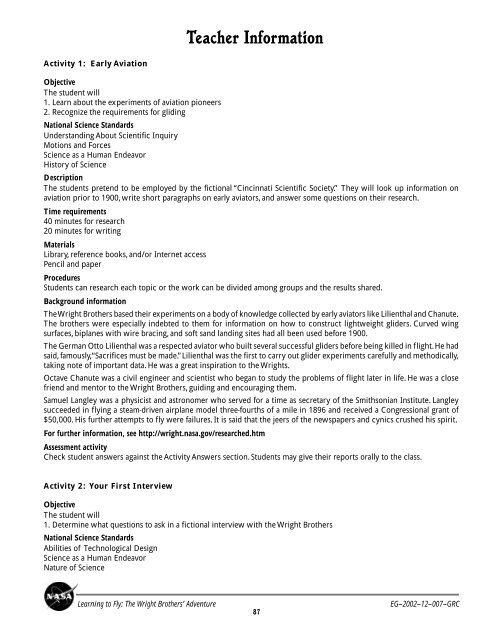Learning to Fly: The Wright Brothers Adventure pdf - ER - NASA
Learning to Fly: The Wright Brothers Adventure pdf - ER - NASA
Learning to Fly: The Wright Brothers Adventure pdf - ER - NASA
- No tags were found...
You also want an ePaper? Increase the reach of your titles
YUMPU automatically turns print PDFs into web optimized ePapers that Google loves.
Teacher InformationActivity 1: Early AviationObjective<strong>The</strong> student will1. Learn about the experiments of aviation pioneers2. Recognize the requirements for glidingNational Science StandardsUnderstanding About Scientific InquiryMotions and ForcesScience as a Human EndeavorHis<strong>to</strong>ry of ScienceDescription<strong>The</strong> students pretend <strong>to</strong> be employed by the fictional “Cincinnati Scientific Society.” <strong>The</strong>y will look up information onaviation prior <strong>to</strong> 1900, write short paragraphs on early avia<strong>to</strong>rs, and answer some questions on their research.Time requirements40 minutes for research20 minutes for writingMaterialsLibrary, reference books, and/or Internet accessPencil and paperProceduresStudents can research each <strong>to</strong>pic or the work can be divided among groups and the results shared.Background information<strong>The</strong> <strong>Wright</strong> <strong>Brothers</strong> based their experiments on a body of knowledge collected by early avia<strong>to</strong>rs like Lilienthal and Chanute.<strong>The</strong> brothers were especially indebted <strong>to</strong> them for information on how <strong>to</strong> construct lightweight gliders. Curved wingsurfaces, biplanes with wire bracing, and soft sand landing sites had all been used before 1900.<strong>The</strong> German Ot<strong>to</strong> Lilienthal was a respected avia<strong>to</strong>r who built several successful gliders before being killed in flight. He hadsaid, famously, “Sacrifices must be made.” Lilienthal was the first <strong>to</strong> carry out glider experiments carefully and methodically,taking note of important data. He was a great inspiration <strong>to</strong> the <strong>Wright</strong>s.Octave Chanute was a civil engineer and scientist who began <strong>to</strong> study the problems of flight later in life. He was a closefriend and men<strong>to</strong>r <strong>to</strong> the <strong>Wright</strong> <strong>Brothers</strong>, guiding and encouraging them.Samuel Langley was a physicist and astronomer who served for a time as secretary of the Smithsonian Institute. Langleysucceeded in flying a steam-driven airplane model three-fourths of a mile in 1896 and received a Congressional grant of$50,000. His further attempts <strong>to</strong> fly were failures. It is said that the jeers of the newspapers and cynics crushed his spirit.For further information, see http://wright.nasa.gov/researched.htmAssessment activityCheck student answers against the Activity Answers section. Students may give their reports orally <strong>to</strong> the class.Activity 2: Your First InterviewObjective<strong>The</strong> student will1. Determine what questions <strong>to</strong> ask in a fictional interview with the <strong>Wright</strong> <strong>Brothers</strong>National Science StandardsAbilities of Technological DesignScience as a Human EndeavorNature of Science<strong>Learning</strong> <strong>to</strong> <strong>Fly</strong>: <strong>The</strong> <strong>Wright</strong> <strong>Brothers</strong>’ <strong>Adventure</strong> EG–2002–12–007–GRC87
















